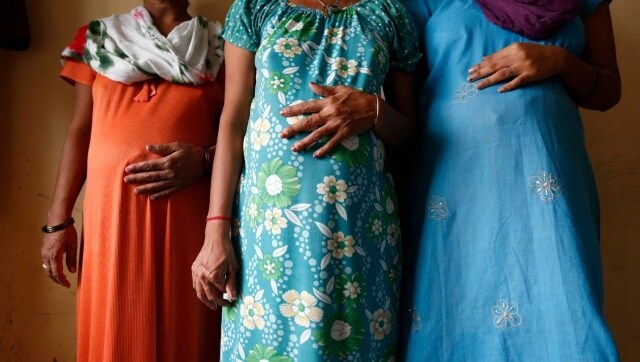Explained: Amid Britney Spears' disclosure about IUD imposed on her, a look at history of forced sterilisation across the world
Forced sterilisation is a violation of rights relating to many different aspects — information, reproduction as per one's choice, health, privacy and dignity.

Representational image. Reuters
When Britney Spears spoke in an open court on 23 June in the ongoing case concerning her conservatorship, she spoke about how it was allegedly abusive and curtailed her freedom of movement. Among some of the more startling details that emerged was that Spears was not allowed to get her IUD (intrauterine device) removed, even though she wanted to get married and have a baby.
The conservatorship, and especially this detail about the IUD, have brought into focus how forced temporary and permanent sterilisation is imposed on women across the globe, especially those who live with disabilities or have marginalised identities.
What is forced sterilisation?
Sterilisation, when done voluntarily, involves using a range of methods to control fertility or permanently end it. Forced or coerced sterilisation "occurs when a person is sterilised after expressly refusing the procedure, without her knowledge or is not given an opportunity to provide consent," as per the Human Rights Watch. Incentives which are financial in nature or take other forms; misinformation; and intimidation tactics are some of the ways through which people are compelled to undergo coerced sterilisation. Oftentimes, the lines between voluntary and involuntary sterilisation are blurred due to incentives promised, or the lack of adequate information — such as the belief that sterilisation is the only form of contraceptive available.
Tubal ligation, essure, vasectomies, hysterectomies, and IUDs are among the means used to sterilise individuals.
Forced sterilisation is a violation of rights relating to many different aspects — information, reproduction as per one's choice, health, privacy and dignity.
Sterilisation has been weaponised into a policy to tackle the issue of large and rising populations, to enact gender-based violence, to enact torture upon individuals, to curb the spread of HIV-AIDS, and in acts of ethnic genocide. "Forced sterilisation is an act of violence, a form of social control, and a violation of the right to be free from torture and other cruel, inhuman, or degrading treatment or punishment," a report by a UN Special Rapporteur on torture, punishment and other degrading acts mentions.
What are the impacts of forced sterilisation?
Forced sterilisation leads to trauma, pressures to mental health resulting from the stigma of being sterilised, possible early onset menopause and other issues, according to a report by the European Disability Forum (EDF) and CERMI Women’s Foundation. The report also states that it may make women more vulnerable to sexual abuse, since the abuse becomes easier to hide. If the sterilisation isn't performed in a sterile, sanitised atmosphere, the risk of infection, disease and even death becomes higher for the patient.
Have certain communities been specifically targeted?
People with disabilities, those who suffer from mental health issues, trans and intersex individuals, ethnic minorities, indidviduals who have HIV-AIDS, and the poor are among the groups of people upon whom sterilisations have been performed across the globe. The idea that these individuals are incapable of taking care of and assuming responsibility for themselves as well as those who may come into their care is what has driven this discriminatory practice. This notion of fitness — or rather the lack of it — has also been applied along the lines of race, driven by the theory of eugenics.
The history of the practice in India
The government of India was the first in the world to control the fertility of its population on a large scale, a move that occurred parallel to the international birth control movement. The most infamous instance of forced sterilisation in India is the mass drive conducted in 1976 during the Emergency, under the authority of Sanjay Gandhi. Villages were reportedly cordoned off, and men were virtually dragged by the police to undergo surgeries. Sterilised men and women were sometimes offered land in exchange for undergoing the procedure, as well as prompting others to do so too, reports Quartz.
Sometimes, there was the looming threat of being fired from a government job if one refused to be sterilised. In 1976 alone, 6.2 million men were sterilised via mass vasectomy camps. Two thousand of them reportedly died due to botched up procedures.
The drive in the 1970s was prompted by loans from the World Bank, the Swedish International Development Authority and the UN Population Fund, reports the BBC. But even before Partition and India's independence, the local populace, especially women, were seen as being in need of contraception and birth control. Katherine Mayo and the founder of the birth control movement, Margaret Sanger, both described the women of India as impoverished and incapable of taking care of their children.
After the 1970s, family planning has been focused on women. Sterilisation via tubal ligation is more popular in India than anywhere else in the world; the national figure for the procedure stands at 39 percent. Many recent reports of sterilisation in India highlight the large-scale rate at which they are performed, as well as the fact that they are conducted in unsafe and unsanitary conditions. The 2014 case in Chhattisgarh where over a dozen women died, and the case of the sugarcane cutters in Maharashtra who are urged by the contractors who hire them to undergo hysterectomies, are examples of this issue.
Forced sterilisation policies and drives in other parts of the world
The world's first sterilisation law was passed in the US state of Louisiana in 1907. The theory of eugenics was the reason that over 60,000 people were sterilised in the US, reports The Conversation. The American stance on race and eugenics is said to have informed Nazi Germany's notion of eugenics, too. The Third Reich passed the Law for the Prevention of Offspring with Hereditary Diseases in 1933, under which over 4,00,000 children and adults were sterilised. Many of these people were Jews. Unwanted sterilisations continue in the US, especially in the country's prisons.
"From the 1930s through the 1980s, Japan, Canada, Sweden, Australia, Norway, Finland, Estonia, Slovakia, Switzerland, and Iceland all enacted laws providing for the coerced or forced sterilisation of mentally disabled persons, racial minorities, alcoholics, and people with specific illnesses," a paper in the Public Health Reviews of the Biomed Central journal mentions.
In North China, the women of the minority Uighur community have been subject to mass sterilisation, unconsented insertion of IUDs and forced abortions, reportedly in an attempt to suppress the community's population. China already had a history of forced sterilisation when its One-Child Policy was in place, along with forced abortions and the abandoning of countless children. In Peru and former Czechoslovakia, too, there have been histories of forced mass sterilisation.
Recently, some progress has been made when it comes to legislation against the practice. In Bolivia, France (against the rule that trans people must undergo the procedure before changing their gender identity on birth certificates), Africa, and on a global level through the UN, forced sterilisation has been termed "inhuman" and "a violation of rights and due process".
also read

Euro 2020: Heavyweights Spain, Portugal, Germany under pressure ahead of final group matches
Germany need a draw to reach the last 16 but defeat would see Hungary go through and possibly condemn Joachim Loew's side to another group-stage exit, just like at the 2018 World Cup.

Euro 2020: Emil Forsberg's penalty helps Sweden beat Slovakia, on brink of qualifying for last 16
A point in their final game against Poland at the Krestovsky Stadium on Wednesday would be enough to be sure of a top-two finish in the group.

Euro 2020: Scotland set to end 23-year wait against Czech Republic; COVID-hit Spain face Sweden
England's neighbours Scotland, playing at the highest level for the first time since the 1998 World Cup, will face the Czech Republic in Glasgow on Monday.